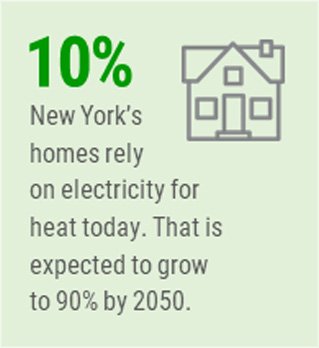Forecasting Future Heating: How Electrification Challenges Future Grid Planning

Forecasting future demand on the power grid often begins by looking at historical data to understand how things like temperature changes can influence demand. For instance, on New York’s power grid, air conditioning is largely responsible for driving peak demand. As temperatures rise in the summer, air conditioning load increases. Understanding that relationship is important to prepare the grid to reliably meet peak demand conditions. Decades of historical data on how temperatures influence demand from air conditioning helps the NYISO accurately forecast future load based on expected and extreme temperature conditions.
But what happens when new technologies, like heat pumps and electric vehicles, are expected to significantly change demand patterns and consumer behavior on the grid? How do energy planners get the system ready for these new technologies if no historical data exists?
New York’s Climate Leadership and Community Protection Act requires
significant electrification of the building sector, which has historically relied almost exclusively on fossil fuels for heating needs. In fact, only 10% of New York’s homes rely on electricity for heat today. That is expected to grow to 90% by 2050, with electric heat pumps considered the leading technology to convert fossil-fuel-based furnaces and boilers. As heat pump technology proliferates, peak demand on New York’s grid is expected to shift from summer to winter.
With little historical data on the electrical demand associated with heat pumps, the NYISO teamed with the Electric Power Research Institute (EPRI) on a study to model how demand in individual homes is likely to change with the conversion to heat pumps. Specifically, the study examined how air source heat pumps with supplemental electric resistance heating equipment will impact peak demand and overall energy use.
The study takes a bottom-up approach to planning, modeling the performance of an individual residential heat pump for an entire year to understand how wider deployment of the technology will shape future demand on the grid. Overall, the study found heat pump technology performs similarly to conventional central air conditioning in the summer months while performing more efficiently than gas furnaces or electric resistance only heating systems. However, the technology’s contribution to peak demand during winter months will be significant, requiring careful reliability planning to prepare the system.
The results of the study can be applied to the different usage characteristics for other homes after accounting for differences in size, construction, and other factors. Through this extrapolation, forecasters will begin to form a picture of what kinds of demands heat pumps will place on the power grid.
Beyond heat pumps, the state’s electrification efforts will mean new uses and new demands for the power grid. Whether it’s from heating, vehicles, or green hydrogen production, anticipating the impacts of those new demands on the grid well in advance is essential to support long-term reliability. Results from this effort and others will continue to evolve with improved understanding of emerging electrification technologies and, ultimately, inform policymakers and market participants about future investment needs on the grid to reliably achieve the state’s ambitious electrification goals.
For more information about how the NYISO forecasts demand on the grid, please click here.
